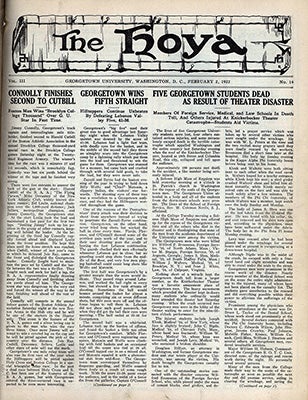Thanks to the generous support of a group of Hoya alumni, the first decade of The Hoya (January 14, 1920-May 22, 1930) has been digitized and is available in DigitalGeorgetown for searching and browsing. The gift was given in the name of Sergeant Stubby, the Boston terrier mix and decorated war hero who arrived at Georgetown in 1922 with veteran tuned law student J. Robert Conroy. Stubby served as mascot for the Georgetown football team for several years. The 1920s Hoya joins issues from 1959-1980 which were previously digitized.
Student newspapers have significant research value. The Hoya documents student perspectives on issues and events, trends and controversies, and decisions and policies that have impacted and shaped the University and those associated with it. Recently I
have used the 1920s Hoya to answer questions about the Knickerbocker Theatre disaster in January 1922, in which five Georgetown students died along with 93 others when the roof of an Adams Morgan movie theater collapsed under the weight of heavy snow; and about Georgetown alum Alford Williams who set the world air speed record in his Curtiss Racer in 1925. Digitized issues of The Hoya have also supplied needed information about the first Diplomatic Ball held at the Mayflower Hotel in December 1925 and the appointment of a Chinese language instructor in the School of Foreign Service in 1929.
As well as searching for specifics in response to research and reference requests, however, I have enjoyed the act of simply browsing through Hoya issues on my computer, becoming sidetracked by fascinating glimpses of a school where Freshman will not wear bow ties before 7 o'clock in the evening, according to the Freshman Rules printed in September 1929, or where a controversy between the Bricklayer’s and Plasterer’s Unions delayed work on New North for over six weeks in 1925. I have also learned about a number of intriguing off-campus happenings. For instance, according to The Hoya, Volume 2, No. 1, in the summer of 1920 Jim Sweeney (C’1922) caught Agnès Souret (the prettiest girl in France) from his seat in the balcony at the Folies-Bergere in Paris, France, after she fell from a basket suspended high over the audience. And, according to a column written by Erik Kjellstrom (C’1930), who competed for Sweden in the 400 meter hurdles at the 1928 Olympic Games, Mademoiselle [Halina] Konopacka, a Polish discus thrower, was so happy at winning Olympic gold that she danced around the field and kissed several of the judges.
If you have a research need that would benefit from a study of student perspectives, or just a love of Georgetown history and traditions and a few minutes to spare, who knows what you might find in the pages of The Hoya online or in hard copy in the University Archives.
And, of course, individuals or groups who would like to help preserve and make the The Hoya more accessible by sponsoring the digitization of a decade of issues should contact the University Archivist for more details.
Lynn Conway, University Archivist
July 14, 2016



